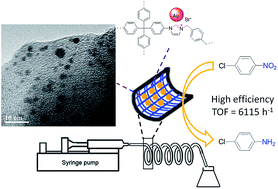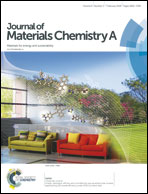Gold nanoparticles confined in imidazolium-based porous organic polymers to assemble a microfluidic reactor: controllable growth and enhanced catalytic activity†
Abstract
A synthetic strategy is developed to grow Au nanoparticles supported by imidazolium-based porous organic polymers (Au/IM-POPs) along the inner surface of a fused-silica microfluidic capillary. The thickness of the hybrid Au/IM-POP material layers can be tuned by changing the precursor concentration. A variety of imidazolium-based porous organic polymers are developed from tetrakis[4-(1-imidazolyl)phenyl]methane and bromo-functionalized linker molecules and fully characterized, which may be used to support Au nanoparticles. Additionally the IM-POPs and Au/IM-POPs show porosity and the ability to take up guest molecules. The capillary coated with Au/IM-POPs is further assembled to obtain a catalytic microfluidic reactor. The catalytic activity of Au nanoparticles supported by the porous imidazolium polymer is probed by using the reduction of nitrobenzene derivatives flowing through the microfluidic reactor. The catalytic microfluidic reactor demonstrates significantly enhanced turnover frequency magnitudes in comparison with the corresponding reactions under batch conditions.

- This article is part of the themed collection: 2018 Journal of Materials Chemistry A HOT Papers


 Please wait while we load your content...
Please wait while we load your content...